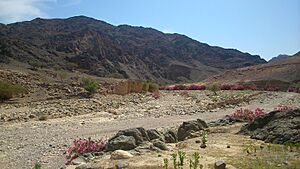Wadi Feynan facts for kids
Wadi Feynan (also spelled Wadi Faynan) is a big valley in southern Jordan. It's like a seasonal riverbed, meaning water flows through it only at certain times of the year. This important valley is located where the Tafilah Governorate, Aqaba, and Ma'an Governorates meet.
Wadi Feynan starts in the southern Jordanian Highlands. It forms where two smaller valleys, Wadi Dana and Wadi Ghuweyr, join together. From there, it flows into the Dead Sea by way of Wadi Araba.
This area is famous for its history, especially for its rich copper deposits. In fact, it had the largest copper mines in the Southern Levant, which is a historical region in the Middle East. Many important ancient sites have also been found here.
The large amounts of copper in Wadi Feynan helped a "copper culture" grow quickly. People started mining and melting copper ore as early as the Chalcolithic period (around 4500 to 3100 BCE). They continued to produce copper all the way up to the Mamluk period (1250 to 1516 CE).
In 1983, German scientists explored the region. They found that the amount of copper produced in Wadi Feynan was huge. It was more than anywhere else in the southeastern Mediterranean, except maybe for the copper mines on the island of Cyprus.
Copper production became very common when Wadi Faynan was part of the Kingdom of Edom. This was around 1000 BCE. It's thought that the Egyptian pharaoh Shoshenq I played a big role in improving copper technology. In the late 10th century BCE, the way copper was made became more standard across a large area. This included Wadi Faynan and the Timna Valley mines. Also, the amount of copper left in the waste (called slag) dropped a lot. This showed that people were getting much better at processing the ore.
Today, part of Wadi Feynan is protected within the Dana Biosphere Reserve. The Royal Society for the Conservation of Nature (RSCN) opened an eco hotel there in 2005. This hotel, called the Feynan Ecolodge, was their first of its kind.
Discovering Ancient Sites
Wadi Feynan is home to many fascinating archaeological sites. These are places where scientists study the remains of past human life and activities.
Some of the important sites include:
- Barqa al-Hetiye
- Khirbat Faynan
- Khirbat en-Nahas
- Wadi Faynan 16
Digging Up History
Archaeologists have done a lot of digging at the sites in Faynan. A project called the Edom Lowlands Regional Archaeology Project has led many of these excavations. It was led by Thomas E. Levy and Mohammad Najjar.
These researchers believe that the Iron Age sites in the region are linked to the very first stages of the Biblical kingdom of Edom. Levy, Najjar, and another scholar named Erez Ben-Yosef also suggest something interesting about Pharaoh Shoshenq I of Egypt. Shoshenq I (also known as "Shishak" in the Bible) attacked Jerusalem in the 10th century BCE. Instead of destroying the region, these scholars think he actually encouraged the trading and making of copper in Wadi Feynan.
See also
- Museum at the Lowest Place on Earth
- Timna Valley


